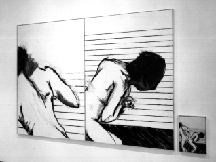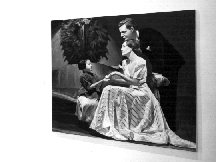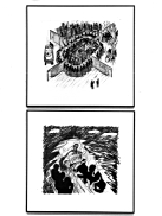- MAIN INDEX | ARTIST INDEX
| March 6 - March 31, 1984 80/1/2/3/4 Toronto: Content and Context Curated by Richard Rhodes | |
 Content and Context: John Brown, installation view, 1984. Photo Peter MacCallum. 18K |  Content and Context: Joanne Tod, installation view, 1984. Photo Peter MacCallum. 18K |
 Content and Context, installation photo of works by Sandra Meigs, 1984. Photo Peter MacCallum. 18K | |
| PRESS RELEASE
Mercer Union is pleased to present the group exhibition On exhibition will be the work of the following fifteen Toronto artists: Shelagh Alexander, John Brown, David Clarkson, Oliver Girling, Will Gorlitz, Nancy Johnson, Dyan Marie, Sandra Meigs, Stephen Menzies, Andy Patton, Jaan Poldaas, John Scott, Joanne Tod, Renee Van Halm, Robert Wiens. Guest curator Richard Rhodes has grouped together some of the best work produced in Toronto over the past four years. Rhodes describes the exhibition as "an existential catalogue, a record of fifteen imaginations presenting us with a sense of what it is like to be alive now." Content - Context
Todd Davis No matter what some individuals may think or say, it is extremely interesting to watch the skies part while yet another gathering of visual delectables from our brothers and sisters in Mecca descends from the heavens to land in Vancouver for our cultural enjoyment. I do not want to sound as if I am not appreciative of an opportunity to walk out my front door and into a neighbouring gallery to partake in viewing formalised conceptions from an art scene of which I have primarily printed knowledge and some personal encounters, but questions must be asked if this is the dialogue people intend to send us. Dialogue, the absent entity which BM constantly derides Vancouver for being incapable of generating on a level to his satisfaction. Dialogue, of which intent, influences and/or politics are the ingredients. The dialogue, if you are not an isolationist, is the final work. Two titles were utilised by the curator, Richard Rhodes, for this stagery. One, an attempt to chronicle the past five years in Toronto (80/1/2/3/4) with 15 artists and one work or small series from each. This is akin to profiling the Toronto Blue Jays pitching and batting statistics after only 4 weeks of a 28 week season and then projecting them as winners of the American League East. Is there a hidden stamp, A-1 Prime, that we individuals west of the Rockies are not aware of for assessment purposes? Can Mr. Rhodes be asking us to put aside those international influences and provincial ideas that so inflict us; to put in his hands our complete faith that this exhibition is a standard from which we are to gauge future productions? Take for instance the curator's second title for this exhibition: Content - Context. I really hate to break it to the poor man, but several of his artists were educated under the same system as myself, and all of these individuals finance their production under the same system as we do here in Vancouver. The intents, influences and/or politics differ very little between major cities in this country no matter what opinions some critics hold. Pure ambiguity results from a statement such as Content - Context, with only two inane directions possible for our ignorant little minds to travel: these artists have taken the bull____ in hand to produce a Toronto (read Canadian) artistic context via the individual content of these works. A bit troublesome considering the flagrant deficiencies inherent in the curator's intentions and most of the art. Or, that making art within the context of Toronto is too different from Vancouver, Halifax, Alma or Winnipeg that only the objective fundamentalism of southern Ontario will permit this art to occur. On one hand it's true, artists in Vancouver have utilised the concepts present at the C.A.G. and stepped beyond what adorns the walls. The spectrum is larger and we are aware of the fact that the provincial attitudes which inflict this show like a terminal disease are below us. If TO has the desires and needs to produce this specific art it merely means our time can be better spent. As with most group shows, and some individual exhibitions, the 20/80 theory comes into practice. This presentation fits the bill quite nicely as a matter of fact with 20 percent worth the viewer's time and 80 percent of the work battling to pull down the other 20%. Dialogue amongst Vancouver artists, curators and writers so far has produced a consensus concerning one piece, Will Gorlitz's The Distant World, a provocative production that strikes a cord with everyone no matter what their ritual for personal satisfaction and/or information gathering. To walk along the gallery wall and view your subjective reflection in the canvases hanging high at an angle to your face was more than rewarding, whether you find your needs in a morning cup of coffee, an afternoon or evening paper or the downtown corner stock market data sign. The collaged cutouts from Der Speigel which surrounded the bottom edge of the four paintings were really unnecessary; an extension that anyone reading or scanning any paper other than the Vancouver Province is aware of to the nth degree. And even if the artist did feel the need to pull the work itself into mixed (multi) media territory for fear of being pigeon-holed as a painter, with photos of a struggling society, he could have made an effort to utilise the four European dailies illustrated in paint. A valiant and provocative piece of art, and one which should be in the VAG's permanent collection of contemporary Canadian art. Joanne Tod's work has been as long time in arriving here on the West coast. Why? I couldn't begin to speculate. As for this painting placing in my top 20% the reasons are as simple as the piece itself. Maybe I should qualify that statement of simplicity with the adage that you must be bored to tears with artists incapable of rendering; thus there is a breakdown in communication of intent/communication and as a result very little or no dialogue. Do not take this to mean that without drawing capabilities you cannot call yourself an artist. There are some photographers, sculptors, video artists and installationists who are very adept at communication and the world would be a boring space without them. They are part of the spectrum necessary for contemporary culture. Back to Ms. Tod who has produced what I would refer to as a reverse version of the centralism I referred to in a past Issue. Three figures inhabit the canvas titled My Father, Rob and I structured in a quasi-triangular formation forcing the viewer's eyes toward the centre. Once there we find an unfinished area of painting which should have been the older female figure lovingly holding hands with the child. Unrequited love, or a relationship which soured at an influential time in the child's youth possibly? The memory of a dead elder or is it that Tod found herself incapable of actually painting anatomically correct hands? The overall painting leads me, at least, to believe that the intent was purposeful and like an exorcism necessary for subsequent paintings. Paintings which we on the west coast will no doubt be unable to view. Everyone should be familiar with Shelagh Alexander's storyboard photo collages as a result of the media coverage and recent Vancouver show. To date, the Dora Series is the only narrative capable of running full tilt while gathering us, the viewers, along for the ride. Robert Wiens' third person narrative about a native bush pilot, Dream and Dissolutionment, was another work which received a consensus vote of approval. The remaining works were either incompetent art or masturbation or both. Why can't someone attempt to overcome the 20/80 syndrome with a curated show from across the country. In other words consult local galleries, curators, writers and especially artists so we can view the best that all regions have to offer. It can't be that difficult can it?
80/1/2/3/4/
Tim Guest 80/1/2/3/4/ was the title of a group exhibition of fifteen Toronto artists, a selection of their work produced in the current decade. Curator Rick Rhodes selected the artists on the basis that their work has "emerged or resolved itself over the last four years", connoting a status as a new generation of Toronto art as well as being a registration of the cultural climate of recent times. On first viewing, such a selection of artists might seem merely eclectic, operating through different media and around separate themes. Yet there are a few common features which distinguish the work of these artists. For one thing, whatever anyone might say of the newness of this generation, the work is, if not exactly indebted to, at least openly influenced by the work of the 70's: to the intellectual rigours of conceptual art, to the narrative and autobiographical strains of video and performance, and simply to those artists whose work emerged at an earlier stage. While this may be an obvious analysis it is worth noting insofar as these are the times in which artists have supposedly ditched concept art in order to go mental, daubing and jabbing at the easel. It is therefore most interesting to find a distinct continuity between the art of the 70's and the newer work produced by the artists in this exhibition. Pieces by Shirley Wiitasalo, lan Carr-Harris, or Robin Collyer (while they are not included) would hardly look out of place in the context of this show. Even the minimalist aesthetic of Jaan Poldaas' vibrant geometric paintings (included in the exhibition) seems not years away but another, compatible, strain among contemporary concerns. The popularisation of painting in the 80's has in Toronto, resulted in pictures evolved out of the reasoned framework of conceptual art. While there is a very broad practice of painting, a number of artists have become involved in the subjective interpretation of public or mass-media imagery as a predominant theme. The development of this kind of subjective awareness is quite significant. While it verges on autobiography, it is unlike earlier work in this vein as the tone is anything but confessional. The project of artists such as Will Gorlitz, Andy Patton, and Joanne Tod, (and to some extent John Scott, Nancy Johnson, David Clarkson, and Shelagh Alexander) appears to be the assertion of the usefulness of personal interpretations insofar as they articulate the ways in which an image is internalised by an individual, and further, the role these images might play in forming individual identities. Through this kind of subjectivity the artist attempts to specify a form of alienation at the same time as s/he alludes to a rich potential found in the vivid associations of the imagery. This is certainly a different form of autobiography than that which prevailed in the 70's. Yet it is difficult to imagine the existence of this work without the precedence and validation of the personal accounting of video artists such as Vito Acconci, Colin Campbell. or Lisa Steele. Another interesting distinction to be made in regarding this exhibition is the relationship these artists maintain to their representational means: that is, very few artists here make "paintings" or "sculpture". With the exception of Girling and Brown who are "painters" and Poldaas and Menzies whose work belongs to a strain with close ties to minimalism, the other eleven artists in the exhibition display a telling self-consciousness over the formal presentation of their work. These artists are normally engaged in an attempt to transform the conditions of art's viewing: they are trying to show their work in a way that will defeat an audience's expectations of gallery art, of ''painting" and "sculpture" and so lead to better communication and a fresh approach. They are suspicious of the conventions of representation and seem intent upon inventing a new snare for the viewer. For instance, Will Gorlitz hung his paintings of coffee cups at a 45* angle in the context of a complete collage environment: a simulated domestic interior replete with corresponding press clippings. Dyan Marie's low relief sculptures were as closely related to ornamental kitchen plaques as to ''sculpture'', despite their abstract twisting, floating and metamorphosing motions. Sandra Meigs gouaches were, in fact, lushly-produced story boards for a film project. Renee Van Halm's work practically revolves around an examination of various means of representation, historical and contemporary. Robert Wiens' History Looking Upon Itself lay on the floor as a heap of heroic sculptural elements: a hand grasping a hammer, an orb, wagon wheel, pieces of arms and legs, and a rearing horse' s head . Wiens presented a neoclassical dump, a wry reference to the repressive and impressive qualities of the monumental sculptural tradition. Equally, Wiens' collection of heroic parts suggested a melancholic ambivalence towards the romantic ideals of historical sculpture, a contradiction between a desire to utilise and criticise. This work reflects a paradoxical relationship to representation, to the form of sculpture, to historical imagery. It is as though by embracing the hollow formula of sculpture history will finally give up the ghost, the formulae will dissolve and a new means of envisioning will come about; the world is transformed, ironically. To suggest all of the above is perhaps to read too much into the exhibition for not much was evident in its actual presentation besides the titles and the works themselves. Curator Rick Rhodes made an interesting and commendable selection of artworks. Yet the exhibition fell short of being either provocative or instructive. The exhibition was subtitled "Content/Context" yet neither content nor context were at all articulated. Rhodes' expressed hope was that this exhibition open up a discussion on the meaning of current work and the conditions of art production in Toronto (it is this writer's obligation to pitch in for the achievement of Rhodes' ambition). The exhibition itself was not self evident without documentation. The audience at Mercer Union was bound to leave the gallery pleased to have been stimulated by some dynamic art but mystified over the exhibition s intended meaning as a body of art works.
| |